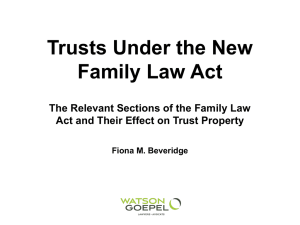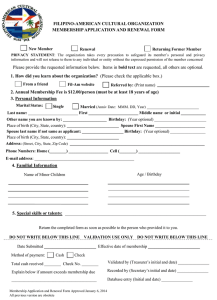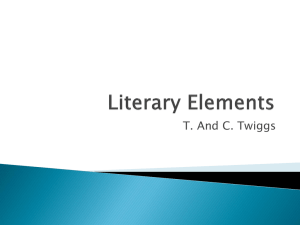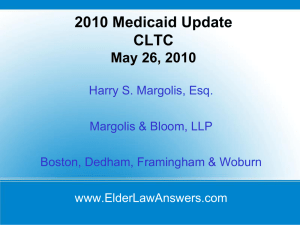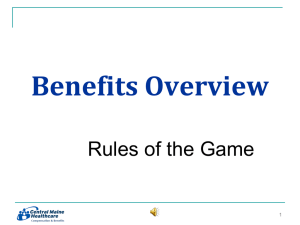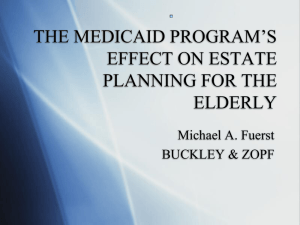Medicaid in Pennsylvania - Power Point - Law
advertisement
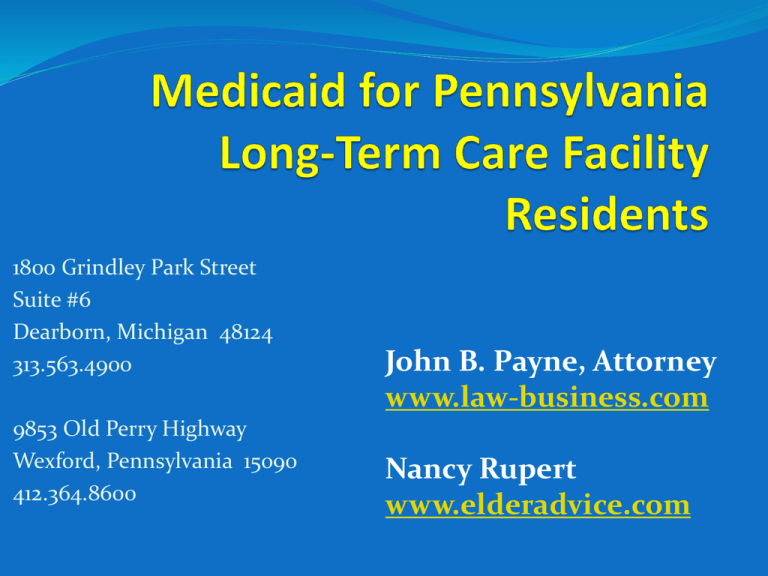
1800 Grindley Park Street Suite #6 Dearborn, Michigan 48124 313.563.4900 9853 Old Perry Highway Wexford, Pennsylvania 15090 412.364.8600 John B. Payne, Attorney www.law-business.com Nancy Rupert www.elderadvice.com Medicaid • Federally subsidized grant-in-aid for low-income • • • • individuals and families; i.e., welfare Varies from state-to-state Covers medically necessary services and most prescriptions No cap on covered services Stringent eligibility requirements 2 Medicaid for Long-Term Care Financial eligibility criteria for MA Need for long-term care Not necessary to qualify for "skilled care," but must be verified that applicant cannot be cared for in community 3 Limits on Countable Assets No Community Spouse–$2,400 $8,000, if income less than $2,022 in 2011 (three times SSI amount) 4 2009-10 Community Spouse Resource Allowance Calculate "total joint resources" on the day one spouse enters long-term care--the "snapshot.“ Half may be retained: Minimum $21,912 maximum $109,560 Maximum automatic in some states Once institutionalized, spouse is approved for MA, community spouse's assets are no longer counted. 5 Community Spouse Spend Down 6 Community Spouse Spend Down 7 Community Spouse Spend Down 8 Two Significant Dates Date institutionalized spouse enters LTC or a hospital leading to long-term care Date community spouse spends down so resource allowance is met 9 Home is Exempt, but Planning is Necessary to Avoid Estate Recovery 10 Household and Personal Goods • Household goods – Customarily found in home – Used in conjunction with maintenance or occupancy • Personal goods – Incidental items intended for personal use by a household member – Personal goods held for investment purposes not excluded 11 Motor Vehicle One motor vehicle of any value excluded Most expensive excluded Additional vehicle also excluded if homestead, or necessary for selfsupport 12 Income-Producing Real Property and Assets Used in Trade or Business Income producing real property (IPRP) and personal property used in a trade or business may be excluded. The extent of this exclusion is unclear, but it should apply if the property produces a reasonable rate of return. 13 Prepaid Funeral May be Non-countable 14 Funeral and Burial Arrangements No absolute limit but Agency may review amount to determine whether it is “exorbitant for person’s situation.” Higher amount justified for: Transport of body. Priest, minister or rabbi who is close friend or relative to conduct services with cost of travel, food, lodging and honorarium to be paid from burial reserve. Reasonable gift to church or synagogue for facilities. Limits from $8,125 in Clinton County to $14,062.50 in Bucks County. 15 Other Types of Property Can be Used to Preserve Assets and Still Qualify Toys Jewelry 16 IRA Loophole (in some states) The Community Spouse’s IRAs and 401(k)s are all exempt! 17 Jointly-Held Liquid Assets Totally available to MA applicant or recipient. If joint tenant for estate planning, but neither a current claim of right nor unrestricted access, unavailable and not counted. Considered divested when funds removed. 18 Jointly Held Real and Personal Property Unavailable if held jointly with rights of survivorship No sale not without consent of other owners and the other owners do not consent Creation of joint tenancy divestment if client’s ownership or control reduced 19 Myth—You Can’t Give Anything Away and Get Medicaid You can be disqualified for giving away property--in some cases. What is given away? To whom? When? 20 Permissible Transfers Disabled child Child who has lived in claimant’s home for two years and provided care Sibling of claimant who has lived with claimant for one year and has equity 21 Conversion Exchange of asset for property of equal value not divestment Example: purchase of $100,000 annuity for $100,000 22 Divestment Gifts subject to five-year look-back. Penalty begins when donor is otherwise eligible for Medicaid. 23 Example: Rosco, a widower, is in good health when he gives his grandson $25,000 for college. He keeps $75,000 in savings. Three years later, he suffers a stroke and enters a nursing home at $6,500 per month. Four years and three months after the gift, he runs out of money. He cannot get assistance for a number of months. Divide $25,000 gift by average cost of private-pay care in a nursing home. 24 Penalty Period Begins when patient is eligible but for the penalty After lapse of prior penalty Amount divested divided by state average daily private- pay nursing home rate, $247.06 in 2010 Length of disqualification measured in days 25 Saving Rosco Vital to act on entering LTC Additional $25,000 gift Annuitize or loan remaining funds 26 Protecting Assets through Irrevocable Annuities 27 Qualifying Annuities Irrevocable Unassignable No cash value Purchased at fair market value Commercially available All required payments must be paid within annuitant’s actuarial life expectancy State must be named as beneficiary on death of annuitant in the amount of Medicaid payments 28 Two Prongs of Spousal Protection An individual shall not be ineligible for medical assistance . . . to the extent that . . . assets were transferred to the individual's spouse or to another for the sole benefit of the individual's spouse, [or] were transferred from the individual's spouse to another for the sole benefit of the individual's spouse. § 1396p(c)(2)(B). No income of the community spouse shall be deemed available to the institutionalized spouse. § 1396r5(b)(1). 29 Sole-Benefit Test: Transmittal 64 Annuities are “usually purchased to provide a source of income for retirement.” “In order to avoid penalizing annuities purchased as part of a retirement plan . . . . If the expected return on the annuity is commensurate with a reasonable estimate for the life expectancy of the beneficiary, the annuity can be deemed actuarially sound.” State Medicaid Manual § 3258.9(B). http://www.cms.hhs.gov/Manuals/PBM/list.asp?listpage=2 30 Contrary States States that place restrictions on the use of Transmittal 64-compliant annuities--generally limiting annuities to funds that are part of the CSRA: Alabama Connecticut Minnesota North Dakota Wisconsin Arkansas Indiana Nevada Ohio Colorado Louisiana New Jersey Texas 31 Protecting Assets through Irrevocable Trusts Not in the U.S. Third Circuit New Jersey Pennsylvania Delaware Virgin Islands Check local Medicaid rules 32 Strategies When Both Spouses Are in Long-Term Care Facilities 33 Defining Characteristics “Institutionalized spouse” means an individual who is in an institution or, if there is a waiver needs nursing care, and is married to a spouse who is not in a medical institution or nursing facility. §1396r5(h)(1)(A). “Community spouse” means the spouse of an institutionalized spouse. §1396r-5(h)(1)(B). 34 Institutionalized Equals Single When a couple ceases to live together, the agency must count only the income of the individual spouse in determining his or her eligibility, beginning the first month following the month the couple ceases to live together. 42 CFR § 435.602(a)(3). 35 Advantage: Couple In the case of eligible institutionalized spouses who have shared the same room in a Medicaid institution, the agency has the option of considering these couples as eligible couples for purposes of counting income and resources or as eligible individuals, whichever is more advantageous to the couple. 42 CFR § 435.602(a)(4). 36 Viable Devices to Preserve Assets: Divestment Investment in homestead Annuities Sole benefit trusts (except Third Circuit) 37 2011 Pennsylvania Medicaid Limits Community Spouse Resource Allowance: Minimum: $21,912 Maximum: $ 109,560 One-person Asset Limit: $2,400 ($8,000 low-income) Monthly Maintenance Needs Allowance: Minimum: $ 1,822 Maximum: $ 2,739 Shelter Standard: $ 547 Standard Utility Allowance: $ 524 Monthly Personal Needs Allowance: $ 45 Transfer Penalty Divisor : $259.76/day 38

